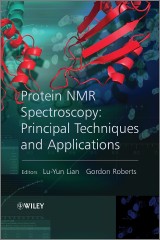Details

Protein NMR Spectroscopy
Practical Techniques and Applications1. Aufl.
|
91,99 € |
|
| Verlag: | Wiley |
| Format: | EPUB |
| Veröffentl.: | 09.06.2011 |
| ISBN/EAN: | 9781119972822 |
| Sprache: | englisch |
| Anzahl Seiten: | 368 |
DRM-geschütztes eBook, Sie benötigen z.B. Adobe Digital Editions und eine Adobe ID zum Lesen.
Beschreibungen
<p>Nuclear Magnetic Resonance (NMR) spectroscopy, a physical phenomenon based upon the magnetic properties of certain atomic nuclei, has found a wide range of applications in life sciences over recent decades. This up-to-date volume covers NMR techniques and their application to proteins, with a focus on practical details. Providing newcomers to NMR with practical guidance to carry out successful experiments with proteins and analyze the resulting spectra, those familiar with the chemical applications of NMR will also find it useful in understanding the special requirements of protein NMR.</p>
List of Contributors xiii <p>Introduction 1<br /> Lu-Yun Lian and Gordon Roberts</p> <p>References 4</p> <p><b>1 Sample Preparation, Data Collection and Processing 5</b><br /> <i>Frederick W. Muskett</i></p> <p>1.1 Introduction 5</p> <p>1.2 Sample Preparation 5</p> <p>1.3 Data Collection 11</p> <p>1.4 Data Processing 17</p> <p><b>2 Isotope Labelling 23</b><br /> <i>Mitsuhiro Takeda and Masatsune Kainosho</i></p> <p>2.1 Introduction 23</p> <p>2.2 Production Methods for Isotopically Labelled Proteins 24</p> <p>2.3 Uniform Isotope Labelling of Proteins 29</p> <p>2.4 Selective Isotope Labelling of Proteins 32</p> <p>2.5 Segmental Labelling 37</p> <p>2.6 SAIL Methods 38</p> <p>2.7 Concluding Remarks 45</p> <p><b>3 Resonance Assignments 55</b><br /> <i>Lu-Yun Lian and Igor L. Barsukov</i></p> <p>3.1 Introduction 55</p> <p>3.2 Resonance Assignment of Unlabelled Proteins 56</p> <p>3.3 15N-Edited Experiments 60</p> <p>3.4 Triple Resonance 62</p> <p>3.5 Side-Chain Assignments 77</p> <p><b>4 Measurement of Structural Restraints 83</b><br /> <i>Geerten W. Vuister, Nico Tjandra, Yang Shen, Alex Grishaev and Stephan Grzesiek</i></p> <p>4.1 Introduction 83</p> <p>4.2 NOE-Based Distance Restraints 84</p> <p>4.3 Dihedral Restraints Derived from J-Couplings 96</p> <p>4.4 Hydrogen Bond Restraints 103</p> <p>4.5 Orientational Restraints 107</p> <p>4.6 Chemical Shift Structural Restraints 129</p> <p>4.7 Solution Scattering Restraints 137</p> <p><b>5 Calculation of Structures from NMR Restraints 159</b><br /> <i>Peter Guntert</i></p> <p>5.1 Introduction 159</p> <p>5.2 Historical Development 161</p> <p>5.3 Structure Calculation Algorithms 164</p> <p>5.4 Automated NOE Assignment 173</p> <p>5.5 Nonclassical Approaches 178</p> <p>5.6 Fully Automated Structure Analysis 181</p> <p><b>6 Paramagnetic Tools in Protein NMR 193</b><br /> <i>Peter H.J. Keizers and Marcellus Ubbink</i></p> <p>6.1 Introduction 193</p> <p>6.2 Types of Restraints 194</p> <p>6.3 What Metals to Use? 200</p> <p>6.4 Paramagnetic Probes 203</p> <p>6.5 Examples 209</p> <p>6.6 Conclusions and Perspective 212</p> <p><b>7 Structural and Dynamic Information on Ligand Binding 221</b><br /> <i>Gordon Roberts</i></p> <p>7.1 Introduction 221</p> <p>7.2 Fundamentals of Exchange Effects on NMR Spectra 222</p> <p>7.3 Measurement of Equilibrium and Rate Constants 229</p> <p>7.4 Detecting Binding – NMR Screening 238</p> <p>7.5 Mechanistic Information 241</p> <p>7.6 Structural Information 246</p> <p><b>8 Macromolecular Complexes 269</b><br /> <i>Paul C. Driscoll</i></p> <p>8.1 Introduction 269</p> <p>8.2 Spectral Simplification through Differential Isotope Labelling 270</p> <p>8.3 Basic NMR Characterisation of Complexes 273</p> <p>8.4 3D Structure Determination of Macromolecular Protein–Ligand Complexes 277</p> <p>8.5 Literature Examples 297</p> <p><b>9 Studying Partially Folded and Intrinsically Disordered Proteins Using NMR Residual Dipolar Couplings 319</b><br /> <i>Malene Ringkjøbing Jensen, Valery Ozenne, Loic Salmon, Gabrielle Nodet, Phineus Markwick, Pau Bernado´ and Martin Blackledge</i></p> <p>9.1 Introduction 319</p> <p>9.2 Ensemble Descriptions of Unfolded Proteins 320</p> <p>9.3 Experimental Techniques for the Characterisation of IDPs 320</p> <p>9.4 NMR Spectroscopy of Intrinsically Disordered Proteins 321</p> <p>9.5 Residual Dipolar Couplings 323</p> <p>9.6 Conclusions 340</p> <p>References 340</p> <p>Index 347</p>
<p>"This is a must for anyone interested in using solution NMR to study proteins. <b>Summing Up: Highly recommended.</b> Graduate students, researchers/faculty, and professionals/practitioners." (<i>Choice</i>, 1 April 2012)</p>
<p><strong>Professor Gordon Roberts</strong> is Head of the School of Biological Sciences, University of Leicester. <p><strong>Dr Christina Redfield</strong> is Reader, Oxford Centre for Molecular Sciences, University of Oxford.
<p>Nuclear Magnetic Resonance (NMR) spectroscopy, a physical phenomenon based upon the magnetic properties of certain atomic nuclei, has found a wide range of applications in life sciences over recent decades. The dramatic advances in NMR techniques have led to corresponding advances in the ability of NMR to study structure, dynamics and interactions of biological macromolecules in solution under close to physiological conditions. This volume focuses on the use of NMR to study proteins.</p> <p>NMR can be used to determine detailed three-dimensional structures of proteins in solution. Furthermore, it provides information about conformational or chemical exchange, internal mobility and dynamics at timescales varying from pcoseconds to seconds. It is the primary technique used to obtain information on intrinsically disordered (unfolded) proteins, since these proteins will not crystallize easily. NMR is also a very powerful method for the study of interactions of protein with other molecules, whether small molecules (including drugs), nuclear acids or other proteins.</p> <p>This up-to-date volume covers NMR techiniques and their application to proteins, with a focus on practical details. This book will provide a newcomer to NMR with the practical guidance in order to carry out successful experiments with proteins and to analyze the resulting spectra. Those who are familiar with the chemical applications of NMR will also find is useful in understanding the special requirements of protien NMR.</p>


















